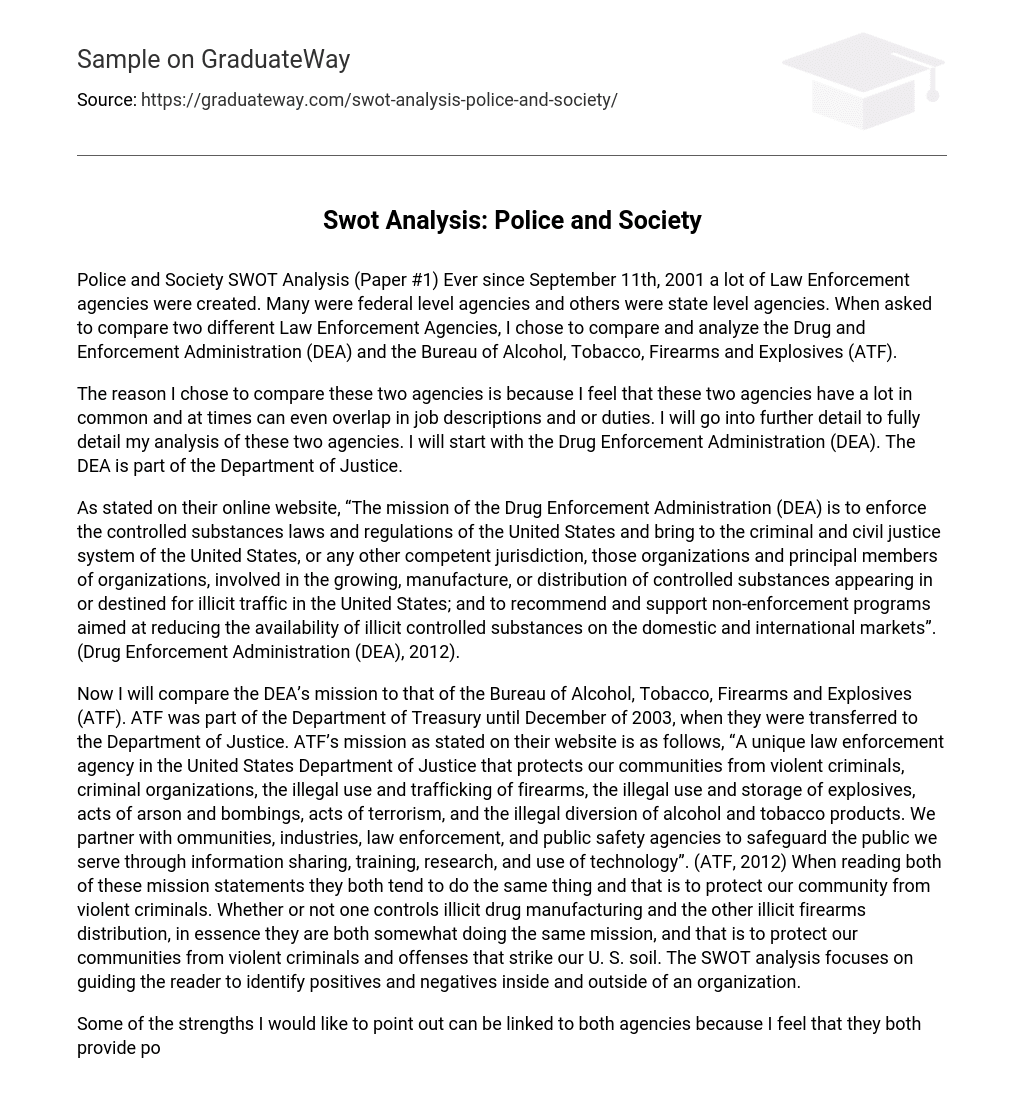Police and Society SWOT Analysis (Paper #1) Ever since September 11th, 2001 a lot of Law Enforcement agencies were created. Many were federal level agencies and others were state level agencies. When asked to compare two different Law Enforcement Agencies, I chose to compare and analyze the Drug and Enforcement Administration (DEA) and the Bureau of Alcohol, Tobacco, Firearms and Explosives (ATF).
The reason I chose to compare these two agencies is because I feel that these two agencies have a lot in common and at times can even overlap in job descriptions and or duties. I will go into further detail to fully detail my analysis of these two agencies. I will start with the Drug Enforcement Administration (DEA). The DEA is part of the Department of Justice.
As stated on their online website, “The mission of the Drug Enforcement Administration (DEA) is to enforce the controlled substances laws and regulations of the United States and bring to the criminal and civil justice system of the United States, or any other competent jurisdiction, those organizations and principal members of organizations, involved in the growing, manufacture, or distribution of controlled substances appearing in or destined for illicit traffic in the United States; and to recommend and support non-enforcement programs aimed at reducing the availability of illicit controlled substances on the domestic and international markets”. (Drug Enforcement Administration (DEA), 2012).
Now I will compare the DEA’s mission to that of the Bureau of Alcohol, Tobacco, Firearms and Explosives (ATF). ATF was part of the Department of Treasury until December of 2003, when they were transferred to the Department of Justice. ATF’s mission as stated on their website is as follows, “A unique law enforcement agency in the United States Department of Justice that protects our communities from violent criminals, criminal organizations, the illegal use and trafficking of firearms, the illegal use and storage of explosives, acts of arson and bombings, acts of terrorism, and the illegal diversion of alcohol and tobacco products. We partner with ommunities, industries, law enforcement, and public safety agencies to safeguard the public we serve through information sharing, training, research, and use of technology”. (ATF, 2012) When reading both of these mission statements they both tend to do the same thing and that is to protect our community from violent criminals. Whether or not one controls illicit drug manufacturing and the other illicit firearms distribution, in essence they are both somewhat doing the same mission, and that is to protect our communities from violent criminals and offenses that strike our U. S. soil. The SWOT analysis focuses on guiding the reader to identify positives and negatives inside and outside of an organization.
Some of the strengths I would like to point out can be linked to both agencies because I feel that they both provide positive enforcements within our communities. Both agencies have a lot of career opportunities and that brings a lot of job openings for the career paths of those holding a Criminal Justice degree. In 2011, the DEA consisted of 9,906 total employees with about 4,890 of them being Special Agents. ATF consists of 5,025 employees with about 2,508 being Special Agents. Even though we can see that DEA has a lot more employees, which in essence is a strength for them. Some weakness for both can be the fact of pay cuts and not enough funding. DEA and ATF both get funding from the Department of Justice. DEA yearly budget is 2 million and ATF is 1 Million.
As we all know our government is at an all time low recession and many jobs that were at one point or another available are either decreasing or non-existent. This creates weaknesses for both agencies and even more so to ATF because they are a fairly new organization so when it comes down to budget cuts; I believe ATF will be the first to get affected. Now for opportunities both agencies offer internship programs and different entry-level positions. Although most of their positions require certain criteria’s to be met, the job positions are still opening because no matter what, new laws and new crimes are developing everyday and when this happens new positions also become available. Also as technology continues to grow so does the level of opportunities available to both agencies.
Finally, what we may all fear, whether you are a supervisor or even someone in an entry-level position and those fears are the threats that can impact any organization. Even though some weaknesses can also be threats. I chose to compare the DEA and the ATF, they both have a lot in common and in a way they can be a threat to one another. The Department of Justice is so spread out and how I mentioned before, a lot of duties and responsibilities can overlap. It be can be very easy for the Department of Justice to eliminate and combine agencies all together and this in fact is a very huge threat to any law enforcement agency. In conclusion, we all know that someone’s loss is another’s gain.
Every Law Enforcement agency can benefit from time to time creating job goals and analyzing by using the SWOT method. The purpose of my paper was to analyze the strengths, weaknesses, opportunities, and threats that surround any law enforcement agency but especially those that correspond to the Drug Enforcement Administration (DEA) and the Bureau of Alcohol, Tobacco, Firearms and Explosives (ATF). Works Cited ATF. (2012, 06 25). Bureau of Alcohol, Tobacco, Firearms and Explosives. Retrieved 06 25, 2012, from ATF online: http://www. atf. gov/about/mission/ Drug Enforcement Administration (DEA). (2012, 06 25). United States Drug Enforcement Administration. Retrieved 06 25, 2012, from DEA: www. justice. gov/dea/agency





